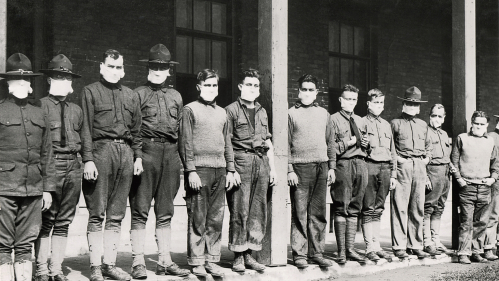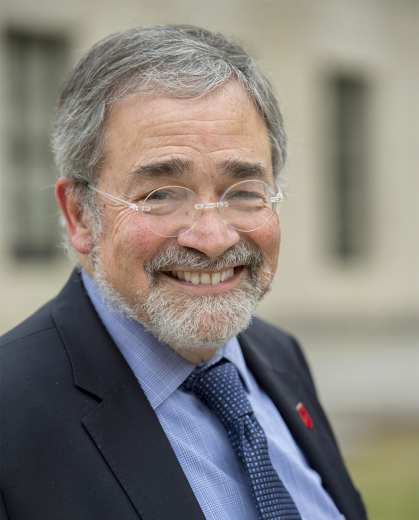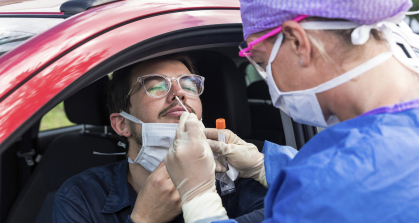The Perfect Storm of Pandemics

Answering questions about COVID-19 and its unique dangers.
Brian L. Strom, chancellor of Rutgers Biomedical and Health Sciences (RBHS) and the university’s executive vice president for health affairs, is a founder of the field of pharmacoepidemiology, which applies epidemiological methods to the study of drugs and their effectiveness within specific populations. He helped develop the International Clinical Epidemiology Network, responsible for fostering the establishment of epidemiology units in medical schools throughout the developing world. A leading expert in outbreaks like SARS, MERS, and seasonal influenza, he notes that the COVID-19 pandemic is unlike any he’s witnessed. As the United States struggles to contain the spread of COVID-19, Rutgers Magazine sought Strom’s insight into the pandemic and the pathogen responsible for it.
RUTGERS MAGAZINE: When did you first learn about the new coronavirus?

BRIAN L. STROM: Like most Americans, I learned of the emergence of the novel coronavirus in Wuhan, China, through the media. In recent years, the public has become more aware of the emergence of new and existing pathogens that pose a threat to global health, such as the Ebola virus, HIV, SARS, MERS, and seasonal influenza. As epidemiologists, however, we commonly monitor disease outbreaks and have long recognized that in our globally interconnected world, a novel pathogen could become epidemic or even pandemic. We were lucky that Ebola and SARS did not spread widely across the world, but it was only a matter of time before circumstances aligned to create the perfect storm that is COVID-19.
RM: Did we learn about it too late?
BLS: The public health history of COVID-19 will show that we missed early warning signs that could have halted the spread of this disease. Unfortunately, the disease became widespread earlier than the Chinese government reported, likely sometime in November. Had China been more forthcoming earlier about the infectivity of this virus, travel restrictions and other interventions could have limited its spread. By January, the public health community was increasingly alarmed about the rapid spread of the virus, because by then it seemed very unlikely that it could be contained in Wuhan. My office began sending out communications in early January. Rutgers then initiated its own Emergency Operations Center in mid-to-late February, anticipating the growing health crisis.
RM: Why was the world so apparently unprepared to deal with this virus?
BLS: In the epidemiological community, we have long anticipated that a pandemic could sweep across the world. Many scenarios similar to the COVID-19 outbreak have been the subject of tabletop exercises to plan for a response, assess vulnerabilities, and avoid catastrophe. There also was a false sense of confidence that global health organizations, NGOs, and our sister nations would communicate frankly, be open to collaboration and cooperation, and collectively contain or mitigate the spread before it got out of control. Unfortunately, through a series of budget cuts and restructuring, much of that preparedness was lost. Then, as the impending pandemic became evident, we did not take it sufficiently seriously. We have seen how policy inconsistencies, denial of scientific facts, infrastructure vulnerabilities, and demographic differences all contributed to our crisis. Once the pandemic surge subsides, world governments will need to rethink how they approach disease management in the “new normal.”
RM: Is this pathogen unusual among coronaviruses for its ability to spread?
BLS: Typically, coronaviruses spread by means of aerosolized droplets through the coughing or sneezing of a contagious person, or by touching surfaces that have been contaminated by the droplets and then touching your face. Normally, coronaviruses just cause symptoms of the common cold. Thus, when you think of how this new coronavirus spreads, think of the common cold and what you know about how the viruses that cause it spread from person to person. What is different about this coronavirus is the severity of the illness that can result, albeit in a minority of patients. It appears to spread even before the infected person is symptomatic. So, people can be out in the community and and spreading the virus without realizing they are infected. This feature of the disease has made contact tracing, a key tool of early epidemiological interventions, particularly challenging. [Contact tracing is the process of identifying people who’ve come into contact with an infected person.]
RM: African-American and Latino populations have been disproportionately affected by COVID-19. Initially, did you anticipate this?
BLS: I did, but that is because those groups unfortunately suffer disproportionately from most diseases. In the case of COVID-19, we do not yet know whether these groups are at higher risk of COVID because they are at higher risk of diabetes, hypertension, obesity, and other underlying conditions, or whether race is an independent risk associated with these groups.
RM: In what ways does this pandemic differ from epidemics that you’ve been involved with?
BLS: At the outset, this pandemic did not appear to be markedly different from the SARS or MERS epidemics in the first two decades of this century. Both were novel coronaviruses that jumped from an animal host, like COVID-19. Both epidemics were largely geographically contained, within East Asia and the Middle East, respectively, and burned out in about six months. The speed with which COVID-19 has spread across the globe, the scope and scale of the necessary interventions, and the immediate economic impact have not been seen since the Spanish Flu pandemic of 1918.
RM: Has COVID-19 taught us anything new about coronaviruses as a group or the nature of pandemics and epidemics?
BLS: Throughout human history, we have faced epidemics and pandemics. The epidemiological interventions we are deploying on a wide scale today would be very familiar to health care practitioners, such as they were, 600 years ago. Mass social distancing, self-isolation, and quarantines were tools developed in the Renaissance to combat plague, typhoid, cholera, and other diseases that we hopefully have consigned to history. The measures are effective in slowing the spread of diseases. People, goods, and information may move across the globe today at an unimaginable speed compared to the past, but the transmission of pathogens occurs by close human contact today, just as it did ages ago.
RM: What do we know (or what can we perhaps surmise) about the virus’s vulnerabilities so far?
BLS: Scientists have identified multiple strains of COVID-19 now in circulation. Whether this virus is susceptible to regular mutation, like influenza, remains to be seen, but major mutations have not yet been seen. It seems vulnerable to soap and handwashing. There is some evidence that the virus is spreading through countries in the southern hemisphere and those along the equator, although possibly more slowly.
RM: Are you optimistic that a vaccine will be developed in the near future?
BLS: Biotechnology and pharmaceutical companies are working rapidly to develop a vaccine as soon as possible. Most companies anticipate moving to stage-two trials (with human subjects) by September, with a prototype available next year. Vaccines were developed for SARS, which is genetically similar to COVID-19, but they didn’t advance beyond animal studies because the disease was contained before widespread human transmission could take place.

RM: If we manage to get the virus under control, can we expect flare-ups until a vaccine is developed?
BLS: Data from Singapore, Hong Kong, Washington, and the San Francisco Bay Area demonstrated that stringent travel restrictions, social distancing, and limited quarantines like those implemented in New Jersey would flatten the infection curve and slow the community spread of the disease. Early in the outbreak, we were seeing case numbers doubling every few days in places like New York City. As testing becomes more available, cases are likely to continue to rise, reflected in hospitalizations and deaths.
When infection rates start to decelerate and go negative, and social restrictions can be relaxed, we will start to see an uptick in new cases as the virus more easily circulates through the community again. We can expect waves of infection, which likely will be the pattern going forward until we develop herd immunity that confers immunity (or at least resistance) to most or all of the population, whether because of widespread infection or (preferably) because of a vaccine.
RM: What do you think is the optimal use of testing in this kind of pandemic?
BLS: Widespread reliable testing and data distribution would have been invaluable at the outset of the pandemic to assist public health agencies in identifying hotspots, implementing local containment measures, tracking close contacts, etc. Unfortunately, these were unavailable for far too long. In part, this was a lack of testing kits, but even as they became more available, testing was limited due to a scarcity of materials like testing swabs and personal protective equipment (PPE) needed to take samples from patients. As access to testing and materials continues to improve, we will be better able to track the movement of the virus through populations and regions, deploy health care personnel and surge capacity, allocate scarce resources, and make better and more targeted decisions about social distancing in order to alleviate broad economic constraints.
RM: Could we have used testing in a way that would have required us to shut down less of the economy and experience less widespread social distancing?
BLS: Earlier testing would have allowed us to identify asymptomatic cases and isolate them from others, limiting the spread of the disease: so-called containment. Early and widespread testing would have shown that the community spread of COVID-19 disease was moving more rapidly than anticipated. Data from such testing could have informed policy decisions earlier, like international travel restrictions, broader social distancing interventions in New York, and disbanding mass gatherings like Mardi Gras in New Orleans and even our own commencement celebrations at Rutgers, which were held remotely. We might have successfully blunted the worst surge of the pandemic, as Singapore and South Korea did. Now, unfortunately, it is too late, and we have moved into the mitigation phase. But at this national scale, such interventions are economically painful and difficult to impose.
RM: What steps do we need to take to help minimize the effects of future pandemics?
BLS: Despite the challenges we still face in presenting a unified front to combat the spread of this virus, the COVID-19 pandemic of 2020 is the loudest wake-up call in over a century. We must build up our public health infrastructure to prevent this and future catastrophes from again causing thousands of deaths, untold numbers of morbidities, perhaps a global recession, and other repercussions we cannot predict. We must invest in a highly trained public health workforce, develop mechanisms for broad sharing of sentinel data across international boundaries, fund biomedical research initiatives, promote effective communication and education, and provide access to primary care to truly mitigate the next global pandemic. None of these investments involves any real innovation or imagination, but failing to adequately fund these core components of a modern public health and health care infrastructure has led us to this moment. It would have been markedly cheaper to have done this before rather than relying on the efforts now underway to limit the impact of this pandemic. We also need to invest in new research and in a citizenry that is educated about science.
RM: Should we be looking for coronaviruses in animals that might spill over into human populations?
BLS: Disease surveillance is a pillar of public health prevention, and monitoring zoonotic diseases [those originating in animals] is an important component of this strategy. There is a perception that novel viruses emerge from exotic live animal markets that are unfamiliar to the West, and genomic evidence does link this coronavirus to bats as a possible source. But virulent diseases like avian flu and swine flu also commonly emerge from the livestock we are more familiar with, like chickens and pigs.
RM: Is there evidence that convalescent plasma donation—transferring the antibodies in the blood plasma of recovered COVID-19 patients to the critically ill—will be effective?
BLS: We don’t yet know whether it will save lives, but preliminary results look promising. It’s vitally important to test this intervention as an option to speed the recovery of critically ill patients and alleviate the pressure on intensive care units and reliance on ventilators.
RM: What were your recommendations for protecting the university community when this virus was gaining momentum?
BLS: The university’s response to the COVID-19 pandemic should be a point of pride for the entire Rutgers community. The university took early, decisive, and scientifically informed action to protect everyone, balanced with our goal to fulfill our mission of education, research, and clinical care to the best of our ability. Closing dormitories; moving to remote education; canceling sporting events, convocations, and even commencement itself were painful decisions but in the best interest of our students, faculty, and staff and of the citizenry of New Jersey.